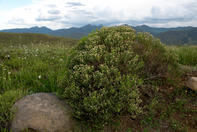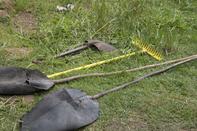A Bleak Outlook
The next 50 to 100 years could see mountain fynbos unable to retreat any further up slopes to cool refugia, and pockets of rare species could be pushed to the brink. Thirstier species may expire as droughts become more frequent and severe. Using five parameters that are imperative to the growth and survival of plants within the fynbos biome, scientists used the theoretical approach of bioclimatic modelling to see what the map of the fynbos biome would look like 50 years from now.

The conclusion was that a 50 per cent loss in the fynbos biome envelope could be expected by 2050, with the greatest loss taking place in the northern limits of the region where less than ten percent of the fynbos community would be able to hold out above 33° south. Species growing high on mountain slopes or towards the southern reaches could also be most vulnerable.
When the climate-habitat window shifts south-eastwards, pushing the biome off the southern tip of the continent, these species would have nowhere else to go but into the grave. Since the biome has a high proportion of endemic species, any loss of range would result in extinctions.
Changing Fire Regime

Increased fire activity is only going to make a bad situation even worse. A large number of the more slow-growing, slow-maturing plants, such as many of the proteas, are expected to suffer most under the onslaught. They will be stunted by the prevailing droughts and cut back more by fire. 'If the frequencies, of fires, are reduced from once in 15 years to once in 5 years, many plant species that are killed by fire, and that rely on re-seeding to survive, would become extinct as they would not have enough time to mature and set seeds between fires.
' The years between fires will become fewer, as will the recovery time for the plants here. In many cases this changing fire regime has already resulted in extinctions in the protea community. Above the city bowl, a type of pincushion protea (Leucospermum vestitum) is lost to Lion's Head and the Burchell's sugarbush (Protea burchellii) is no longer found at its home on Signal's Hill and Devil's Peak due to overly frequent fires. Loss of vegetative cover then impacts on the runoff of rainwater, the stability of soil and the rate of erosion.
Volunteers Bring Hope

The Cape Peninsula National Park volunteer wildfire fighters are doing their utmost to save biodiversity from the ravages of flames. The volunteers have grown to such a size and efficiency that Cape Nature Conservation has called them to assist with fires beyond their jurisdiction - into the Hottentots Holland mountains, the Koegelberg, Cedarberg and surrounds.
Glamorous the volunteer service may seem to new recruits who turn up at the Newlands forestry station to sign onto the team, but training requires a hard slog all year round. In regular training drills recruits go through basic hose and pump exercises, learn to operate the necessary machinery and engines, master abseiling down mountains and rappelling from helicopters as well as on-the-ground firefighting techniques.
During fire season they give up every second Saturday to practise evacuation procedures, usually involving a volunteer strapped into a stretcher who is abseiled down the mountainside. When they are not doing that, they assist with fundraising and clearing the park of alien vegetation.
By Leonie Joubert